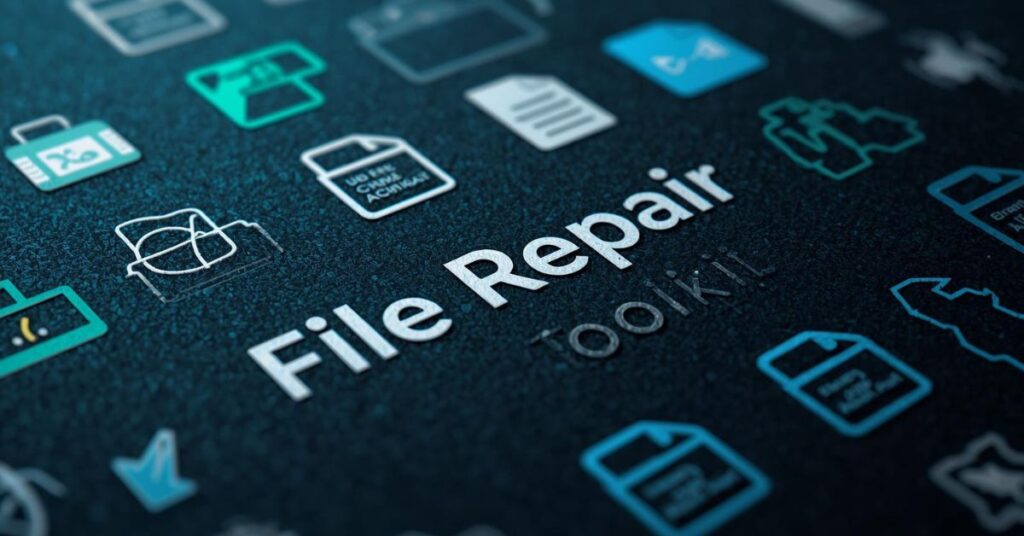Losing access to your Word files, Excel files, PowerPoint files, or a vital PDF document can feel like a nightmare. Whether it’s a business report, an academic project, or a personal record, file corruption always comes uninvited. The good news? There’s a reliable solution — the File Repair Toolkit for Word, Excel, PowerPoint and PDF, also known as the SecureRecovery Office Repair Suite. Designed for professionals, students, and businesses across the USA, this advanced file recovery software restores damaged files, fixes corrupted documents, and prevents future data loss with ease.
What Is File Corruption?
File corruption occurs when a digital file becomes unreadable, incomplete, or fails to open properly. In simple terms, the internal data structure of the file gets damaged due to issues like system crashes, power outages, or malware infections. Imagine spending hours creating a detailed PowerPoint presentation, only to see an error message when trying to open it — that’s classic file corruption.
There are two main types of file corruption: logical corruption and physical corruption. Logical corruption affects the internal coding or metadata of a file, while physical corruption results from damage to the storage device itself. Both can lead to data recovery challenges that demand a professional file repair software for Windows.
A recent case study from a Chicago-based architecture firm featured in Windy City Rehab highlighted this issue. During a renovation project led by Alison Victoria, several Microsoft Office Suite documents became inaccessible after a system crash. The firm recovered every file using the SecureRecovery Office Repair Suite, proving how reliable and versatile this office file recovery toolkit is for real-world situations.
How to Repair Files With SecureRecovery Office Repair Suite
The SecureRecovery Office Repair Suite is a powerful File Repair Toolkit built to repair corrupted Word, Excel, PowerPoint, and PDF files. It’s a trusted solution for users who experience frequent file crashes or need to restore unreadable or inaccessible files quickly.
This professional data recovery suite supports all major formats — from .docx and .xlsx to .pptx and .pdf. It can recover everything from broken text and tables to lost images, embedded charts, and hyperlinks. Its file restoration process ensures data integrity and preserves the original layout, even in heavily damaged files.
Unlike free tools, the SecureRecovery Office Repair Suite guarantees safe data restoration. It works offline, protecting sensitive documents from unauthorized access. Each module (Word, Excel, PowerPoint, and PDF) comes with its own Recovery Wizard, making it simple to follow the file restoration process without technical skills. Users can also rely on technical support specialists and the built-in License Manager for activation and product updates.
Here’s a quick overview of what makes this toolkit stand out:
| Feature | Description |
| File Type Support | Word, Excel, PowerPoint, PDF |
| Recovery Wizard | Step-by-step repair process for damaged files |
| Data Integrity | Maintains original formatting and content |
| Privacy Protection | Works offline for better security |
| System Compatibility | Supports all modern Windows and Microsoft Office versions |
| Customer Support | Expert help from technical support specialists |
A Step-by-step Guide to Using the Office Repair Suite
Using the SecureRecovery Office Repair Suite is simple, even if you’re not tech-savvy. After downloading the installer from the official website, run it with administrator privileges. Once the setup is complete, open the program and select the type of file you want to repair — Word, Excel, PowerPoint, or PDF.
Next, add the corrupted documents you need to fix. You can browse through your folders or drag and drop files directly into the interface. The Recovery Wizard will automatically start scanning the file for errors. During this stage, the toolkit reconstructs broken data and restores file integrity without altering the original content.
Once the process finishes, you’ll see a preview of the restored file. If everything looks good, select a file destination folder and save your repaired version. The toolkit also generates a repair report that details what was fixed, so you know exactly what was recovered. If the tool finds no data to recover error, it will suggest options like manual recovery by experts or sending the file to SecureDrive, an encrypted external hard drive service for secure restoration.
Tips to Help Prevent File Corruption
Even the best File Repair Toolkit or file recovery software can’t replace good habits. Preventing file corruption is always easier than fixing it later. By following a few smart strategies and maintaining proper digital hygiene, you can reduce the risk of data loss, protect your important files, and extend your device’s lifespan.
Create Regular Backups
Backing up your data is your first line of defense against data loss. Use a mix of cloud storage backup solutions like OneDrive or Google Drive and offline methods such as external hard drives or the SecureDrive encrypted external hard drive. Creating automated scheduled backups ensures that even if something goes wrong, your work remains safe.
A good rule of thumb is the 3-2-1 backup strategy: keep three copies of your data, store them on two different media types, and ensure one copy is stored offsite. Whether you’re a small business owner, a student, or a freelancer, regular backups prevent costly downtime and keep your projects safe.
Keep your Software and Firmware Up-to-date
Running outdated software is one of the leading causes of file corruption. Developers release updates to patch vulnerabilities, improve performance, and enhance data security. Keeping your Microsoft Office Suite, operating system, and firmware current helps maintain file integrity and prevents compatibility issues.
| Update Type | Why It Matters |
| Office Updates | Fixes bugs that cause file crashes |
| System Firmware | Improves hardware stability |
| Security Patches | Protects from malware infections |
| Driver Updates | Ensures smooth data transfer |
When possible, enable automatic updates to eliminate the risk of forgetting. Updated systems not only enhance performance but also play a critical role in data loss prevention.
Protect Against Power Loss
Sudden power outages can interrupt active file saving, resulting in damaged or unreadable files. Installing an Uninterruptible Power Supply (UPS) or surge protector is one of the easiest ways to avoid this. For laptops, check your battery health regularly and avoid working with critically low power levels.
Also, turn on AutoSave in Office apps. It automatically stores your work every few seconds, minimizing potential losses during system crashes. Maintaining a steady power supply is key to preventing file corruption before it happens.
Safeguard Your Computer from Malware
Malware infections are among the top reasons for corrupted documents and data loss. Install a reputable antivirus solution such as Bitdefender, Norton, or McAfee, and scan your system weekly. Enable real-time protection, and never open suspicious email attachments or download pirated tools.
Using an encrypted external hard drive like SecureDrive can also prevent unauthorized access and safeguard sensitive information. Remember, antivirus protection and smart browsing habits go hand-in-hand when it comes to keeping your files safe from digital threats.
May Also Read: ##4636## Not Working? (This is How I Fixed it)
Conclusion
File corruption can strike anyone — from a designer saving plans for a Chicago condo renovation to a student finishing their final thesis. With the SecureRecovery Office Repair Suite, restoring your Word, Excel, PowerPoint, and PDF files becomes fast, secure, and effortless.
By following good practices like creating regular backups, keeping your software and firmware up-to-date, protecting against power loss, and defending your computer from malware, you can prevent most data disasters.
As Alison Victoria says on Windy City Rehab, “Every detail matters.” The same applies to your digital work. Protect your files, maintain your system, and keep a File Repair Toolkit for Word, Excel, PowerPoint and PDF ready — because the next crash might come when you least expect it.

Jake Miller is a mobile troubleshooting specialist with 7+ years of experience solving Android and app-related issues. He tests every fix on real devices to ensure accuracy and reliability. Jake creates simple, step-by-step guides to help users quickly resolve everyday smartphone problems.



